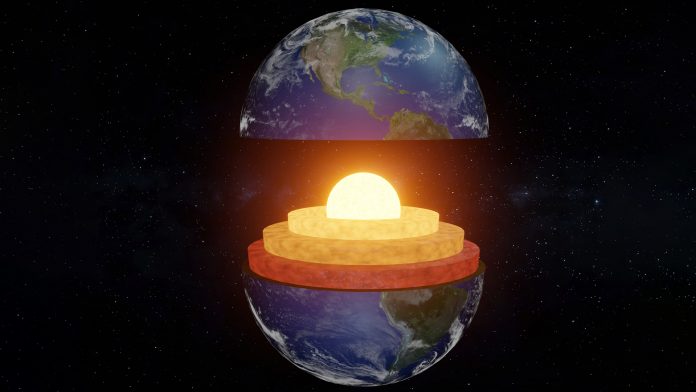An international research group has revealed that aluminous silica plays a major role as a water carrier in Earth’s lower mantle.
The team examined alumina and water contents of silica materials, which are important minerals in the basaltic crust of the upper part of a subducting plate. The results of these examinations show that rutile-type silica – which is widely stable in the upper part of the lower mantle – undergoes a phase transition to a CaCl2-type phase, where it contains water and alumina. This variant can hold more than ten times the amount of water than other lower mantle minerals, even at very high temperatures.
This discovery will lead to the elucidation of the origin of water in the lower mantle, along with the water cycle in the mantle. The results were published in Proceedings of the National Academy of Sciences.
How much water do mantle minerals contain?
Since Earth’s origin, water has travelled through its surface and interior, triggering earthquakes and volcanic activity, and affecting the evolution of Earth’s interior environment. It is estimated that the amount of water that can be stored in Earth’s interior is several times that of seawater on the surface.
Seawater is transported to Earth’s interior by oceanic plates, and to prevent water from leaking from these plates, the minerals within them transport water by incorporating it into their crystal structures. It is thought that these minerals, such as aluminous silica, are transported by the plates to the lower mantle and returned to Earth’s surface by the upwelling plume.
It is still not well understood how much water is stored in Earth’s interior, and how it returns to the surface. To understand these issues, it is important to know how much water mantle minerals contain, and how stably they can hold water.
The role of basalts in transporting water
The researchers discovered that basalts found in oceanic island volcanoes, which are thought to have their source in the lower mantle, contain more water than other basalts. This suggests that the lower mantle plays the role of a major reservoir of water.
However, previous high-temperature and high-pressure experiments have shown that the main lower mantle minerals, which make up peridotite in the lower part of the subducting plate, can hold very little water. This means that it is highly likely that water subducted into the lower mantle is stored in the minerals in basaltic crusts, which is the upper layer of the plate.
Water solubility in aluminous silica
The study focused on silica minerals, which are abundant in basaltic crusts. Although this mineral has been proposed to contain large amounts of water, water solubility in aluminous silica – which most likely exists in basaltic crusts – has not been intensively investigated in lower mantle conditions.
The team synthesised aluminous silica single crystals of high quality at uppermost lower mantle conditions by high-temperature and high-pressure experiments, and determined their precise water content by infrared spectroscopy. As a result, they discovered that the amount of alumina in silica increases with temperature. Above 1,700°C, the average temperature of the mantle, rutile-type silica undergoes a phase transition to a CaCl2-type phase.
The CaCl2-type aluminous silica contains a larger amount of water than rutile-type silica, even above the average mantle temperature. This is more than ten times the water content that other lower mantle minerals can hold. Since the alumina content increases with temperature, the water content is also expected to increase in proportion to temperature.
Previously reported mantle minerals release water with increasing temperature, and their water content generally decreases with temperature. Since temperature increases with depth in the Earth’s interior, this property implies that the water-holding capacity of minerals decreases with depth.
A different discovery to previous theories
When water is released from minerals, it reacts with rocks to form hydrous magma, which separates from the plate and moves to the surface. Therefore, the depth at which minerals release water is considered to be the upper limit of water transport depth.
It has been pointed out that in the lower mantle, which is particularly hot, minerals cannot hold or transport water. Contrary to this belief, the aluminous silica minerals synthesised in this study have a water content that increases with temperature, and can hold large amounts of water under the hottest plume conditions in the mantle. In addition, water released from other minerals is not separated from the plate, but is re-captured by aluminous silica in the basaltic layer of the plate. This allows water to be transported into the deep mantle without losing any, and also allows the transition of water from the lower to the upper mantle.
Due to its unique properties, CaCl2-type aluminous silica may be the most promising water carrier in the lower mantle. In the transition zone and upper mantle, a reverse phase transition from the CaCl2-type phase to rutile-type occurs. Water is thought to be released from silica as a water-holding capacity in aluminous silica decreases.
The local structures of the mantle discovered so far – such as the seismic low-velocity layer just below the transition zone lower mantle boundary, plume ponding at the boundary, and the hydrous transition zone – are thought to be explained by the presence of water. The behaviour of aluminous silica can successfully explain these phenomena.









